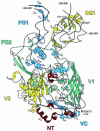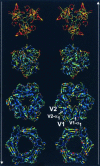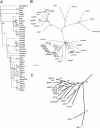Structural and phylogenetic analysis of adenovirus hexons by use of high-resolution x-ray crystallographic, molecular modeling, and sequence-based methods
- PMID: 12915569
- PMCID: PMC187380
- DOI: 10.1128/jvi.77.17.9553-9566.2003
Structural and phylogenetic analysis of adenovirus hexons by use of high-resolution x-ray crystallographic, molecular modeling, and sequence-based methods
Abstract
A major impediment to the use of adenovirus as a gene therapy vector and for vaccine applications is the host immune response to adenovirus hexon-the major protein component of the icosahedral capsid. A solution may lie in novel vectors with modified or chimeric hexons designed to evade the immune response. To facilitate this approach, we have distinguished the portion of hexon that all serotypes have in common from the hypervariable regions that are responsible for capsid diversity and type-specific immunogenicity. The common hexon core-conserved because it forms the viral capsid-sets boundaries to the regions where modifications can be made to produce nonnative hexons. The core has been defined from the large and diverse set of known hexon sequences by an accurate alignment based on the newly refined crystal structures of human adenovirus types 2 (Ad2) and Ad5 hexon. Comparison of the two hexon models, which are the most accurate so far, reveals that over 90% of the residues in each have three-dimensional positions that closely match. Structures for more distant hexons were predicted by building molecular models of human Ad4, chimpanzee adenovirus (AdC68), and fowl adenovirus 1 (FAV1 or CELO). The five structures were then used to guide the alignment of the 40 full-length (>900 residues) hexon sequences in public databases. Distance- and parsimony-based phylogenetic trees are consistent and reveal evolutionary relationships between adenovirus types that parallel those of their animal hosts. The combination of crystallography, molecular modeling, and phylogenetic analysis defines a conserved molecular core that can serve as the armature for the directed design of novel hexons.
Figures





Similar articles
-
Type-specific epitope locations revealed by X-ray crystallographic study of adenovirus type 5 hexon.Mol Ther. 2000 Jan;1(1):18-30. doi: 10.1006/mthe.1999.0001. Mol Ther. 2000. PMID: 10933908
-
Hydropathic characteristics of adenovirus hexons.Arch Virol. 1997;142(7):1307-22. doi: 10.1007/s007050050162. Arch Virol. 1997. PMID: 9267445 Free PMC article.
-
DNA sequence of the adenovirus type 41 hexon gene and predicted structure of the protein.J Gen Virol. 1988 Sep;69 ( Pt 9):2291-301. doi: 10.1099/0022-1317-69-9-2291. J Gen Virol. 1988. PMID: 3411299
-
Capsid-like arrays in crystals of chimpanzee adenovirus hexon.J Struct Biol. 2006 May;154(2):217-21. doi: 10.1016/j.jsb.2005.12.006. Epub 2006 Jan 18. J Struct Biol. 2006. PMID: 16458021 Review.
-
Tropism and transduction of oncolytic adenovirus 5 vectors in cancer therapy: Focus on fiber chimerism and mosaicism, hexon and pIX.Virus Res. 2018 Sep 15;257:40-51. doi: 10.1016/j.virusres.2018.08.012. Epub 2018 Aug 17. Virus Res. 2018. PMID: 30125593 Review.
Cited by
-
Near-atomic structure of an atadenovirus reveals a conserved capsid-binding motif and intergenera variations in cementing proteins.Sci Adv. 2021 Mar 31;7(14):eabe6008. doi: 10.1126/sciadv.abe6008. Print 2021 Mar. Sci Adv. 2021. PMID: 33789897 Free PMC article.
-
Review: Development of SARS-CoV-2 immuno-enhanced COVID-19 vaccines with nano-platform.Nano Res. 2022;15(3):2196-2225. doi: 10.1007/s12274-021-3832-y. Epub 2021 Oct 9. Nano Res. 2022. PMID: 34659650 Free PMC article. Review.
-
New Rabies Vaccines for Use in Humans.Vaccines (Basel). 2019 Jun 20;7(2):54. doi: 10.3390/vaccines7020054. Vaccines (Basel). 2019. PMID: 31226750 Free PMC article. Review.
-
Antigenic variability among two subtypes of human adenovirus serotype 7.Virus Genes. 2014 Aug;49(1):22-9. doi: 10.1007/s11262-014-1071-y. Epub 2014 Apr 24. Virus Genes. 2014. PMID: 24760574
-
Capsid display of a conserved human papillomavirus L2 peptide in the adenovirus 5 hexon protein: a candidate prophylactic hpv vaccine approach.Virol J. 2015 Sep 11;12:140. doi: 10.1186/s12985-015-0364-7. Virol J. 2015. PMID: 26362430 Free PMC article.
References
-
- Athappilly, F. K., R. Murali, J. J. Rux, Z. Cai, and R. M. Burnett. 1994. The refined crystal structure of hexon, the major coat protein of adenovirus type 2, at 2.9 Å resolution. J. Mol. Biol. 242:430-455. - PubMed
-
- Bamford, D. H., R. M. Burnett, and D. I. Stuart. 2002. Evolution of viral structure. Theor. Pop. Biol. 61:461-470. - PubMed
-
- Benkö, M., B. Harrach, and J. C. D'Halluin. 1990. Molecular cloning and physical mapping of the DNA of bovine adenovirus serotype 4; study of the DNA homology among bovine, human, and porcine adenoviruses. J. Gen. Virol. 71:465-469. - PubMed
Publication types
MeSH terms
Substances
Grants and funding
LinkOut - more resources
Full Text Sources
Other Literature Sources

